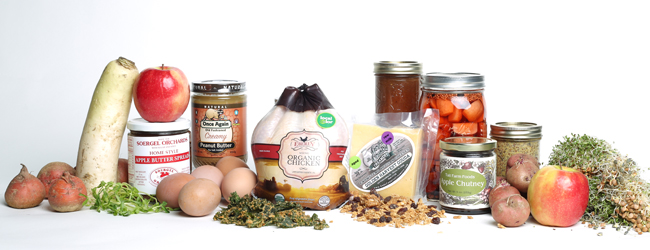Benefits of Eating a Completely Local Diet
I never realized how blessed I was as a child. I grew up with my two sisters and brother on a small farm in a village sandwiched between Blairsville and Derry in Westmoreland County. My mom grew seemingly every vegetable in her greenhouse and in the gardens scattered around our yard. She planted fruit trees, bushes, and a grapevine, from which she made her own jelly and jams. As much as I loved eating my mother’s fresh cuttings from the garden, my favorite part about living on the farm was the animals. Some of our animals — our pony, horses, goat, dogs, and cats — were recreational, while others — the chickens, cows, pigs, and turkeys — served a more purposeful existence (read: food).
When it came time to go to college, I was eager to wave goodbye to farm chores. After graduating and moving to Pittsburgh, little by little, I found myself longing for my old way of life. I noticed it most prominently when I was grocery shopping for the items my mother never had to buy — eggs, vegetables, beef, pork, chicken — and I constantly found myself comparing the quality of the food I was buying to what I ate as a child.
Inspired by the “livet” stories featured in the March issue of Edible Allegheny, I went in search of my own healthy eating and lifestyle plan. I knew it had to be something I could connect with and feel passionate about. And so, I embarked on a 10-day local diet, only consuming food and liquids grown and distributed within a 250-mile radius of Pittsburgh. I was returning to my roots, in a sense.
Sustainability and self-sufficiency would soon become tantamount to my menus, as I could only use the resources available within that self-defined radius. Like our ancestors, I learned the importance of living largely off the land and relying on neighbors for their goods. Lucky for me (and you, too!), the Allegheny mountain region is brimming with such resources. Our rolling hills are blessed with farmers, and our city is populated with food distributors, which make following a local diet easier and appealing.
Want to embark on a local diet yourself? There are a few key prerequisites to consider before beginning. The first is to define the mileage radius from which you will source your food. Second, locate your resources: seek out the farms you want to frequent, find the markets carrying local products, and determine which restaurants are truly farm to table. Third, make a shopping list, gather your recipes, and plan your menu!
My local diet commenced on February 1. After a morning workout of running and yoga, I headed to the East End Food Co-op. Completely ravenous, I was ready to fill my pantry and refrigerator, which at the time was completely bare, with the exception of two dozen eggs from my mom’s chickens. A few days earlier, I visited the Co-op and met with four employees, produce buyer Evan Diamond, grocery manager Maura Holliday, cheese buyer Caldwell Linker, and meat buyer Jess Santacrose, to determine which products would fit into my local diet. I filled my basket with basics that I felt confident about working into several recipes, along with a handful of appealing, new items. Noticeably missing from my shopping cart were my darling fruits and vegetables. As a marathon runner, I tend to eat on the cleaner side, opting for raw or nearly naked cooked fruit and vegetables in an attempt to soak in as much of their natural nutrients as possible. As I peruse the aisles, Diamond points out that most of the green vegetables and fruits I crave are not in season locally right now, and therefore, do not fit into my new eating plan. Instead, he guides me to the winter produce, which includes apples, radishes, beets, and potatoes.
To complete my shopping, I also browsed the Pittsburgh Public Market, where I purchased delicious apple-fennel pork sausage, and beautiful beets and radishes from Clarion River Organics. Certainly not deprived, I snacked on a chocolate, caramel, and Wigle Whiskey-infused cupcake from Eliza’s Oven. I also frequented one of my all-time favorite places, Soergel Orchards in Wexford, to stock up on their famous name-brand butters and cider, and some other local goodies.
I soon learned that the key to a successful local diet is preparation. With the obvious lack of fresh fruits and vegetables grown in the winter months, the best ways to satisfy an appetite for summer foods is through canning, freezing, and stocking your pantry with hearty goods. The Rev. John Creasy, founder of Garfield Community Farm, an urban farm that feeds and educates the Garfield, Morningside, and East Liberty communities about organic farming, described the process of eating a completely local diet as a “learning curve,” explaining that it takes experimentation with these types of practices to maintain a balanced diet all year long. “Education is key to creating a web of food in your own backyard,” Creasy says. While conventional farms are generally forced to stop growing in late fall, Creasy has incorporated new heating techniques into his two-and-a-half acre farm to enable growth through the winter, including an eco-friendly bioshelter, a rocket stove, and even chickens, which individually give off 10 watts of heat. When I visited the farm in January, Creasy was growing tomatoes, kale, lettuce, and broccoli, which he would eventually use in his CSA boxes and sell to local restaurants like Salt of the Earth.
Since I did not prepare my pantry and freezer for eating locally during the winter months, cooking for myself was more complex and time consuming than I was used to. Unless served by my friends at the Whole Foods Market prepared foods counter, my meals are typically pretty simple and lackluster. But as East End Food Co-op Grocery Manager Maura Holiday explained, I was going to have to cook most of my meals and snacks from scratch during this experiment — a simultaneously terrifying and exciting thought. On day one, I made bison burgers with Gouda cheese, Soergel’s pickles, sprouts, and BBQ sauce, with a side of roasted red potatoes. I cooked my very first omelet with Crimini mushrooms, goat cheese, sprouts, and onions. I roasted beets and baked buffalo chicken breasts using hummus from Greek Gourmet Market Place in Squirrel Hill. And, when feeling particularly creative, I whipped up a mishmash of apple-fennel pork sausage, and sautéed radishes, mushrooms, and onions! My favorite dish was a simple grilled chicken breast with sweet apple chutney from Tait Farms. I became intrigued and inspired by the new ingredients I was introducing into my diet, such as goat cheese, chutney, and kale chips. For the first time in my adult life, I was actually enjoying cooking, rather than fearing it, and found it was strangely rewarding to be in the kitchen every night instead of at the grocery store counter.
The most difficult aspect of the local diet was socializing. When eating at home, I had total control of what was on my plate and where it came from, but when I decided to venture out into the world, it was a completely different story — hence why I only tried it once during my experiment. Dining out meant that I had to do actual research and study menus beforehand to find a true farm-to-table restaurant. It was a completely different dining experience than I had ever experienced before. It involved a much more conscious decision than simply meeting up for a bite to eat on a Friday night. I opted for dinner at Grit & Grace, where I indulged in seared hanger steak with crispy potatoes, paired with an Arsenal Cider. I don’t know if it was all of the extra legwork or the especially fresh ingredients, but every bite was divine.
When embarking on a locavore way of life, there is usually an underlying understanding that you will pay more for higher-quality food. Eating locally is an investment of your time, your money, and your life. By the end of my 10-day locavore trial, I realized that it all comes down to respect — respect for food, for the land, and for yourself. I learned that any effort that I can put into eating locally equates to a positive contribution to the local economy and to my body.
The benefits of eating local:
- Local food has more nutritional value. Crops lose nutrients as soon as they are harvested, so the quicker produce moves from the field to the plate, the better.
- There is less chance for contamination. Nowadays, food can travel up to 1,500 miles before reaching shelves. That, combined with handling in the grocery stores, creates a greater opportunity for germs and cross contamination.
- Eating local feeds you and the local economy! It is also a great way to get to know your city and its surrounding farms and markets!
- You develop a real, emotional relationship with your food and the farmers and people who produce it. If you want a specific item, you can call the farmer directly. Or, if there is a problem with your food, you know exactly with whom to speak.
- You will cook more. Eating locally introduces whole foods to your diet and forces you to slow down and be more mindful. Processed foods that are prepackaged for convenience are all but eliminated.
Tips from the pros:
Perhaps one of the most difficult tasks of a eating a locavore diet is avoiding “greenwashing,” which occurs when a restaurant claims to be utilizing local ingredients in its menu when it actually is not. Chef Greg and Ashlee Andrews of The Supper Club at the Greensburg Train Station provide some tips on how to stay true to your roots while dining out. “It’s going to take a little extra time, but you can find your way into the underground network where everyone knows who supports who. You just need to do you research and ask who, what, where, and when,” says Ashlee.
- Start at the farm. Visit farmers markets and talk to the farmers. Ask when was the last time they sold to a certain restaurant and what their favorite restaurants are.
- Read the menu carefully. Many farm-to-table restaurants will list sources within the description; however, be cautious of loose descriptions. Just because it says “local chicken” doesn’t necessarily mean it’s local to Western Pennsylvania. Find out specifically which farm it came from.
- Get in the kitchen. If the information is not listed on the menu, ask the chef where ingredients originate. Many farm-to-table chefs will be happy share the secrets of their local menus.
East End Food Co-op, 7516 Meade St., Point Breeze. 412.242.3598.
Garfield Community Farm, Wicklow St., Garfield.
Soergel Orchards, 2573 Brandt School Road, Wexford. 724.935.1743.
The Supper Club at the Greensburg Train Station, 101 Ehalt St., Greensburg. 724.691.0536.




